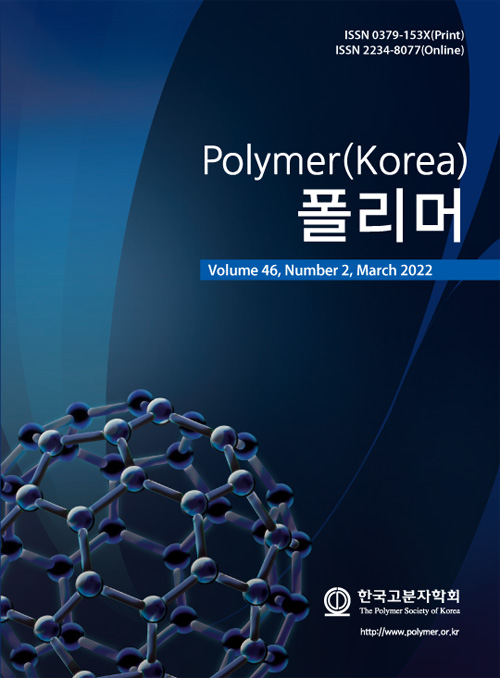- Thermal Properties of Poly(lactic acid) Film Containing Antibacterial Quercetin
Department of Chemical Engineering and Materials Science, Chung-Ang University, 84 Heukseok-ro, Dongjak-gu, Seoul 06974, Korea
- 항균성 Quercetin 함유 Poly(lactic acid) 필름의 열적 특성
중앙대학교 공과대학 화학신소재공학과
Reproduction, stored in a retrieval system, or transmitted in any form of any part of this publication is permitted only by written permission from the Polymer Society of Korea.
When antimicrobial substances are added to poly(lactic acid) (PLA), a biodegradable polymer, the effect on thermal properties has seldom been systematically reported. In this study, the thermal-property influence of natural polyphenol quercetin with antibacterial properties was analyzed when added to PLA. The crystallization rate increased due to the presence of quercetin particles; the cold crystallization temperature decreased, the k value increased, and the half-crystallization value decreased. In the cases of evaporation crystallization, there was no significant change in melting point and melting enthalpy, and lower melting enthalpy values were confirmed in the cases of melt crystallization. Understanding the thermal properties of quercetin/PLA antibacterial films is expected to further enhance the utility of PLA in the future.
생분해성 고분자인 poly(lactic acid)(PLA)에 항균성 물질들의 첨가가 열적 특성에 미치는 영향은 체계적으로 보고된 바가 드물다. 본 연구에서는 항균성 물질인 quercetin을 PLA에 첨가하였을 때 그 열적 특성의 변화를 분석하였다. Quercetin 입자의 존재에 의해 PLA의 결정화 속도가 증가하여, 냉결정화 온도가 낮아지고, k값의 상승과 half-crystallization 시간이 감소하였다. 녹는점이나 용융엔탈피의 경우 증발결정화에서는 유의미한 변화를 보이지 않았고, 용융결정화의 경우 낮아진 용융엔탈피 값을 확인할 수 있었다. Quercetin/PLA 항균 필름의 열적 특성에 대한 이해는 PLA의 생분해성 항균재료 활용성을 고취시킬 수 있을 것으로 예상된다.
Keywords: poly(lactic acid), evaporation crystallization, thermal properties, antibacterial films, quercetin.
- Polymer(Korea) 폴리머
- Frequency : Bimonthly(odd)
ISSN 0379-153X(Print)
ISSN 2234-8077(Online)
Abbr. Polym. Korea - 2023 Impact Factor : 0.4
- Indexed in SCIE
 This Article
This Article
-
2022; 46(2): 223-228
Published online Mar 25, 2022
- 10.7317/pk.2022.46.2.223
- Received on Nov 16, 2021
- Revised on Dec 21, 2021
- Accepted on Jan 5, 2022
 Correspondence to
Correspondence to
- Jonghwi Lee
-
Department of Chemical Engineering and Materials Science, Chung-Ang University, 84 Heukseok-ro, Dongjak-gu, Seoul 06974, Korea
- E-mail: jong@cau.ac.kr









 Copyright(c) The Polymer Society of Korea. All right reserved.
Copyright(c) The Polymer Society of Korea. All right reserved.